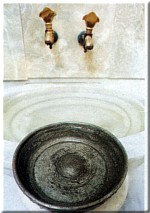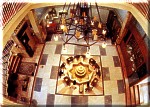The Turkish Bath
Info Turkey ↗
General Travel Information about Turkey.
History ↗
The range is wide and choices are limitless.
Tips for Travelers ↗
Double-check details.

One of the truly unmissable experiences of a trip to Turkey is a visit to the hamam. Like the harem, this Roman and Byzantine tradition was adopted and then perfected by the Selcuk Turks, for whom the public bath took on an important role. It was not merely a place where believers could fulfill the Islamic precept of cleanliness. It was a place in which to mingle, socialize and gossip. Women would proceed from their harem to the hamam with great ceremony, accompanied by servants heavily-laden with delicacies to tide the ladies over the hours they would spend lounging in the steam. The young women used this opportunity to show off their ornately embroidered towels and ivory inlaid slippers, not to mention their youthful figures, while older women would spot potential wives for their sons. Men would discuss the latest court scandal or talk business and politics. Contrary to popular ideas, hamams have always been either permanently designated for one of the sexes, or have a separate schedule for men and women.Traditionally, a whole range of paraphernalia is associated with the hamam. The pestamal, a colourful, checked cloth which is wrapped around the waist by men is still in use. Takunyalar, or wooden clogs, often inlaid or carved, have generally been replaced by plastic flip-flops. Soap, shampoo and other toiletries were carried in hand crafted copper or even gold plated tarak kutusu, literally comb boxes, and a copper tas was used to pour water over the bather. While some of these are no longer used, they are still widely available to buy, and are guaranteed to add to the pleasure of the hamam experience.

Many hamams were built during the Ottoman era, including forty by Sinan himself. Externally, they have a distinctive domed profile, with bottle glass directing beams of light inwards. The first room encountered is the camekan, a square court with a fountain surrounded by small individual changing cubicles. This leads into a small sogukluk, or cooling off section, opening into the hararet, the hot and steamy, marble clad baths.A raised marble platform graces the centre of the hararet. Known as the gobek tasi, or navel stone, it is positioned above the wood or coal furnaces which heat the hamam. The bather lies here for a vigorous massage or a kese, which involves the removal with a rough cloth glove of a lifetimes worth of dead skin. On leaving the hamam, you may recover with a cold drink in the camekan or simply stretch out on the reclining couch in your private changing cubicle.Hamams have largely gone out of fashion in Turkey. However many historical hamams survive, and a visit is highly recommended. In Istanbul the most popular are the historic Galatasaray Hamam in Beyoglu, and Cagaloglu Hamam in Sultanahmet, though local baths are often just as good and much cheaper. Bursa is famed for its baths and spas.
